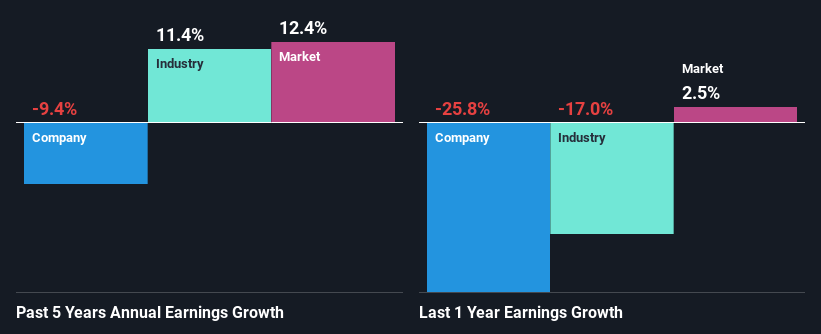Are Poor Financial Prospects Dragging Down HPP Holdings Berhad (KLSE:HPPHB Stock?
With its stock down 5.6% over the past three months, it is easy to disregard HPP Holdings Berhad (KLSE:HPPHB). We decided to study the company's financials to determine if the downtrend will continue as the long-term performance of a company usually dictates market outcomes. Particularly, we will be paying attention to HPP Holdings Berhad's ROE today.
Return on equity or ROE is a key measure used to assess how efficiently a company's management is utilizing the company's capital. In other words, it is a profitability ratio which measures the rate of return on the capital provided by the company's shareholders.
Check out our latest analysis for HPP Holdings Berhad
How Do You Calculate Return On Equity?
The formula for ROE is:
Return on Equity = Net Profit (from continuing operations) ÷ Shareholders' Equity
So, based on the above formula, the ROE for HPP Holdings Berhad is:
5.5% = RM6.9m ÷ RM124m (Based on the trailing twelve months to November 2023).
The 'return' is the profit over the last twelve months. One way to conceptualize this is that for each MYR1 of shareholders' capital it has, the company made MYR0.06 in profit.
What Is The Relationship Between ROE And Earnings Growth?
Thus far, we have learned that ROE measures how efficiently a company is generating its profits. Depending on how much of these profits the company reinvests or "retains", and how effectively it does so, we are then able to assess a company’s earnings growth potential. Assuming all else is equal, companies that have both a higher return on equity and higher profit retention are usually the ones that have a higher growth rate when compared to companies that don't have the same features.
A Side By Side comparison of HPP Holdings Berhad's Earnings Growth And 5.5% ROE
It is quite clear that HPP Holdings Berhad's ROE is rather low. Even compared to the average industry ROE of 7.0%, the company's ROE is quite dismal. Therefore, it might not be wrong to say that the five year net income decline of 9.4% seen by HPP Holdings Berhad was possibly a result of it having a lower ROE. However, there could also be other factors causing the earnings to decline. Such as - low earnings retention or poor allocation of capital.
However, when we compared HPP Holdings Berhad's growth with the industry we found that while the company's earnings have been shrinking, the industry has seen an earnings growth of 11% in the same period. This is quite worrisome.
Earnings growth is an important metric to consider when valuing a stock. What investors need to determine next is if the expected earnings growth, or the lack of it, is already built into the share price. This then helps them determine if the stock is placed for a bright or bleak future. If you're wondering about HPP Holdings Berhad's's valuation, check out this gauge of its price-to-earnings ratio, as compared to its industry.
Is HPP Holdings Berhad Making Efficient Use Of Its Profits?
HPP Holdings Berhad's declining earnings is not surprising given how the company is spending most of its profits in paying dividends, judging by its three-year median payout ratio of 61% (or a retention ratio of 39%). With only very little left to reinvest into the business, growth in earnings is far from likely. Our risks dashboard should have the 2 risks we have identified for HPP Holdings Berhad.
In addition, HPP Holdings Berhad has been paying dividends over a period of three years suggesting that keeping up dividend payments is preferred by the management even though earnings have been in decline. Existing analyst estimates suggest that the company's future payout ratio is expected to drop to 48% over the next three years. As a result, the expected drop in HPP Holdings Berhad's payout ratio explains the anticipated rise in the company's future ROE to 16%, over the same period.
Conclusion
In total, we would have a hard think before deciding on any investment action concerning HPP Holdings Berhad. As a result of its low ROE and lack of much reinvestment into the business, the company has seen a disappointing earnings growth rate. With that said, we studied the latest analyst forecasts and found that while the company has shrunk its earnings in the past, analysts expect its earnings to grow in the future. Are these analysts expectations based on the broad expectations for the industry, or on the company's fundamentals? Click here to be taken to our analyst's forecasts page for the company.
Have feedback on this article? Concerned about the content? Get in touch with us directly. Alternatively, email editorial-team (at) simplywallst.com.
This article by Simply Wall St is general in nature. We provide commentary based on historical data and analyst forecasts only using an unbiased methodology and our articles are not intended to be financial advice. It does not constitute a recommendation to buy or sell any stock, and does not take account of your objectives, or your financial situation. We aim to bring you long-term focused analysis driven by fundamental data. Note that our analysis may not factor in the latest price-sensitive company announcements or qualitative material. Simply Wall St has no position in any stocks mentioned.

 Yahoo Finance
Yahoo Finance 
